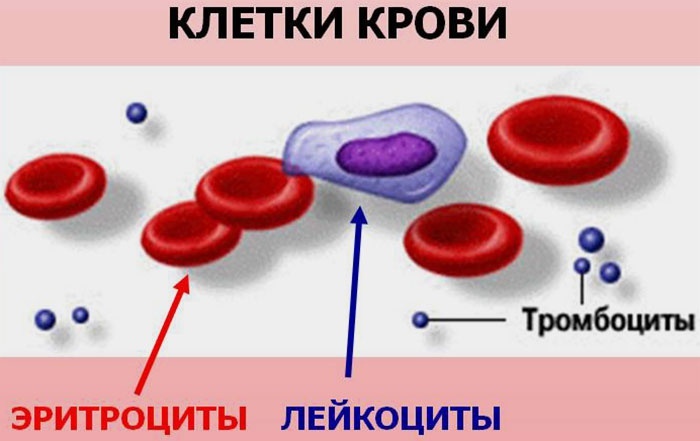Laboratory research methods allow specialists to quickly identify and diagnose various diseases in women. The number of white blood cells( white blood cells) is one of the important indicators of a woman's health. To determine any deviations, they are calculated not only in the patient's blood, but also in her urine and in the vaginal discharge. What will the white blood cells tell before the menstruation?
Contents- 1 Leukocytes in the blood
- 1.1 Normal values in healthy women
- 1.2 White blood cells in women: features
- 1.3 When leukocytes signal disease
- 2 White blood cells in smear: norm and pathology
- 2.1 Standard health indicators
- 2.2 Heightindicators as a sign of the disease
- 3 Leukocytes in urine analysis
- 4 Indicators in analyzes and menstruation
Leukocytes in the blood
One of the main analyzes of modern medicine has been and remains a general analysisz of blood. He gives the doctor the first idea of the presence of a disease in a person and tells the specialist the main directions of diagnostic actions. But how to recognize pathology?
Normal values in healthy women
To identify the disease with a general blood test should be aware of the parameters of white blood cells in the norm. During the life of a person, their number changes:
- From birth to until the child reaches one year in the blood contains 7 - 13 per 109 white blood cells.
- By the age of 12, the number of white blood cells in a child decreases and is 5 to 9 by 109.
- With the growth of the body and the beginning of hormonal adjustment, the value of white blood cells in the blood continues to decrease and by the age of 16 it can reach 4.5-9 per 109.
- Adult maturemen and women have in their blood 4 - 9 per 109 leukocytes, and their number in men is slightly reduced, which is explained by the large volume of circulating blood.

All these external influences lead to a decrease in the liquid fraction of the blood and, consequently, cause the growth of leukocytes.
White blood cells in women: features of
White blood levels in women are affected by various specific conditions of the female body. There is an increase in the number of leukocytes during pregnancy, childbirth and lactation. Such an uniqueness of the female organism is usually explained by doctors for two reasons:
- The main role in the growth process is played by the decrease in the volume of circulating blood and the associated thickening. There is an increase in the percentage ratio of all blood cells, including leukocytes.
- A splash of white blood cells is also a consequence of hormonal rearrangement of the female body under similar conditions.

The representatives of the fair sex also increase white blood cells before menstruation in the blood. Specialists attribute this to the preparation of the woman's compensatory forces for the forthcoming blood loss. You can not exclude the hormonal factor in this process.

When leukocytes signal about
disease Specialists consider the growth of white blood cells in a woman's blood as a sign of the presence of serious pathology in her body. The main reasons for this change in blood analysis are usually:
- Various diseases of the upper respiratory tract. Chronic bronchitis, sore throats and even banal ARVI can lead to the presence of leukocytosis in a blood test.
- A surge in the number of white blood cells will definitely cause any intoxication, and the nature of the poison is not important. With severe poisoning, the number of leukocytes can reach 40-60 per 109.
- Cancer and other processes that reduce the immune forces of the female body can also cause growth of white blood cells in the analysis. Leukocytes before menstruation in the blood, in the presence of such a concomitant pathology, will be further enhanced.
- The sudden increase in white blood cells is sure to result in a postoperative operation, trauma, especially burns and bleeding. In addition to the thickening of the blood, which provokes a change in the indices, in such cases the very natural function of white blood cells is important to fight infection in the body.
It should be noted that in the blood formula, five main types of leukocytes are distinguished. They perform different tasks, and the growth of one species can be compensated for by a decrease in the number of the other. Doctors call this condition a leukocyte formula.
A change in the percentage of different white cells in the blood allows the timely and accurate diagnosis of various diseases of the female body.
Look at the video about white blood cells:
White blood cells in the smear: norm and pathology
When carrying out a diagnostic examination by a gynecologist, a woman must take a swab of the vagina .The data of this analysis allow us to assess the problems of the female sexual sphere.
Leukocytes in the smear before the monthly and their number are one of the indicators of the normal functioning of female genital organs. They can be observed in the analysis and in the absence of pathology in women.
Standard health indicators
The primary examination is a vaginal swab, but to get a more objective picture, you can take the contents of the vaginal mucosa, urethra and cervical canal. Normal values of leukocyte count in these analyzes are:
- in the vaginal smear the number of white blood cells can range from 0 to 15;
- leukocytes in the cervical canal before menstruation are usually slightly elevated, their number exceeds 30, and in the rest of the period in a healthy woman they are in the range from 0 to 25;
- in the study of the urethra should take into account the possibility of the presence of urine, so the white blood cell counts will be in the range from 0 to 7 - 10.

In addition, specialists calmly refer to the increased number of white blood cells before menstruation. If there are no destroyed white blood cells in the analysis and their shape is not changed, then even an increase to 40-50 is not considered a pathology and does not require emergency treatment.
Growth of indicators as a sign of the disease
There are a lot of reasons for the increased number of leukocytes in smears from the vagina. First of all, they include IPP or inflammatory diseases, transmitted sexually. Modern medicine has more than 50.
Most often, these are various diseases caused by bacteria. Here you can include all the known diseases of syphilis, gonorrhea, as well as urogenital mycoplasmosis, chlamydia. Recently, a rather high growth of such a specific disease as tuberculosis of female genital organs has been noted.
The most common pathology in women who are in reproductive age, experts call trichomoniasis. This disease is periodically diagnosed in 70% of the female population of the planet.
 Also gynecologists note a surge of diseases associated with changes in the flora of the vagina. This includes various fungal pathologies, in particular, candidiasis or all known thrush. The main reason for this growth in this type of diseases of the female sexual sphere is the allergic and paradoxical reactions of the female body to various gels, shampoos and creams for intimate hygiene.
Also gynecologists note a surge of diseases associated with changes in the flora of the vagina. This includes various fungal pathologies, in particular, candidiasis or all known thrush. The main reason for this growth in this type of diseases of the female sexual sphere is the allergic and paradoxical reactions of the female body to various gels, shampoos and creams for intimate hygiene.
For successful diagnosis and timely treatment of these diseases, they prefer to take tests from the vagina after the end of menstruation. Experts perfectly understand that in smears, white blood cells are elevated before menstruation, which does not allow to fully assess the severity of the disease and the effectiveness of treatment.
Leukocytes in the analysis of urine
The appearance of leukocytes in the urine of any person is a consequence of the presence of foci of inflammation in the body. In medicine, a phenomenon known as phagocytosis is well known. Doctors call the ability of leukocytes to destroy foreign cells, bacteria and microbes.
In this case, the white blood cells themselves are destroyed and removed from the patient's body with urine. And because absolutely healthy people do not exist, in the analysis of urine there are always leukocytes.
Specialists consider the following number of white blood cells to be normal:
- in men their number ranges from 0 to 3;
- in women, these indicators are slightly higher and make up 1 to 5 white blood cells in the field of vision.

This feature is related to the woman's hormonal background. In pregnancy, the number of white blood cells in the analysis may be 2 to 3 times higher than normal, but this is considered a physiological rise and does not require a specific correction.
Leukocytes in the urine before the monthly also increase and can reach 7 - 10 in the field of view. This process is completely dependent on the level of female sex hormones in the blood.
Specialists note that when taking a urinalysis in a woman during menstrual bleeding should be carefully observed the rules for collecting fluid released from the bladder. Quite often menstrual blood gets into the urine, which makes the analysis unreliable and does not allow to prescribe the woman the necessary therapy.
 We recommend reading the article about lymphocytes with monthly. From it you will learn about the normal parameters of lymphocytes and abnormalities, the causes of increased and decreased lymphocyte content in the woman's blood.
We recommend reading the article about lymphocytes with monthly. From it you will learn about the normal parameters of lymphocytes and abnormalities, the causes of increased and decreased lymphocyte content in the woman's blood.
Indicators in analysis and menstruation
Quite often, women ask a question to doctors in a women's consultation, whether the white blood cells are rising before the menstrual period. The answer, naturally, will be positive. Menstrual cycle of women in terms of the level of changes in the hormonal system is not inferior to the period of pregnancy, therefore changes in blood, urine and vaginal discharge tests will be appropriate.
Women should understand the mechanism of many processes occurring in their body. Some fluctuations in the indicators in the analyzes are possible and should not cause any special concern.
Any young lady should undergo a preventive checkup twice a year, including a gynecologist. There, a woman will be able to get a full and detailed consultation about her health, including the peculiarities of the behavior of the female body before the month.


